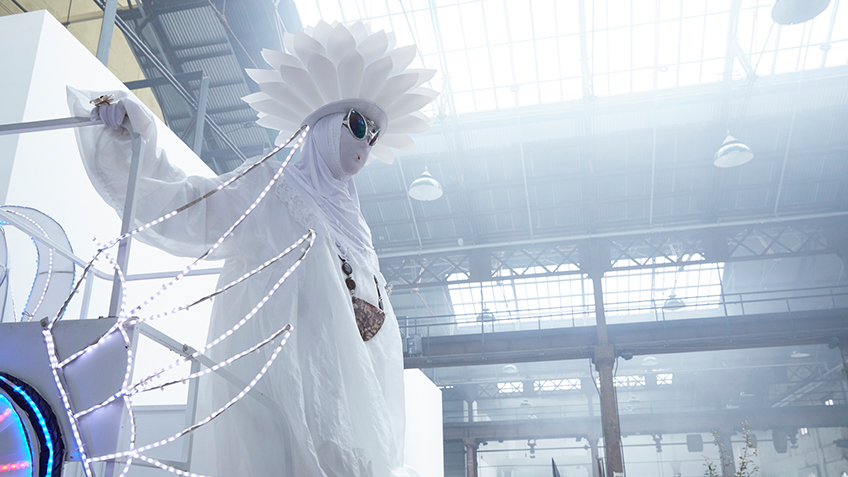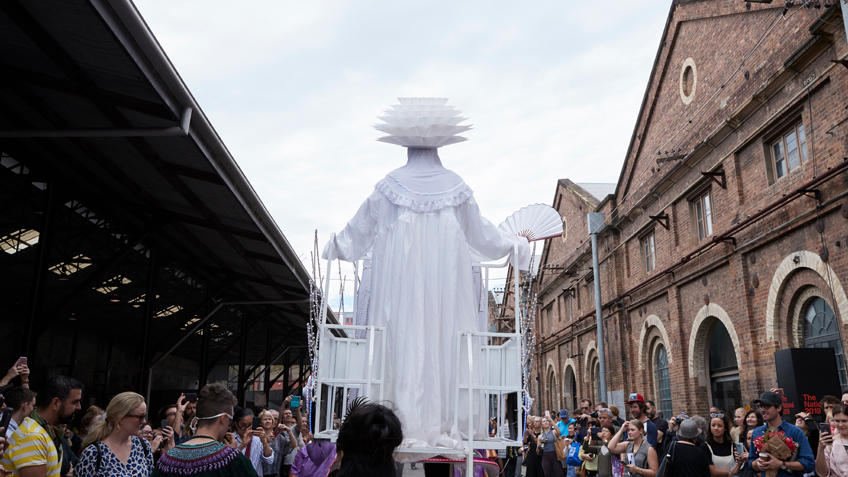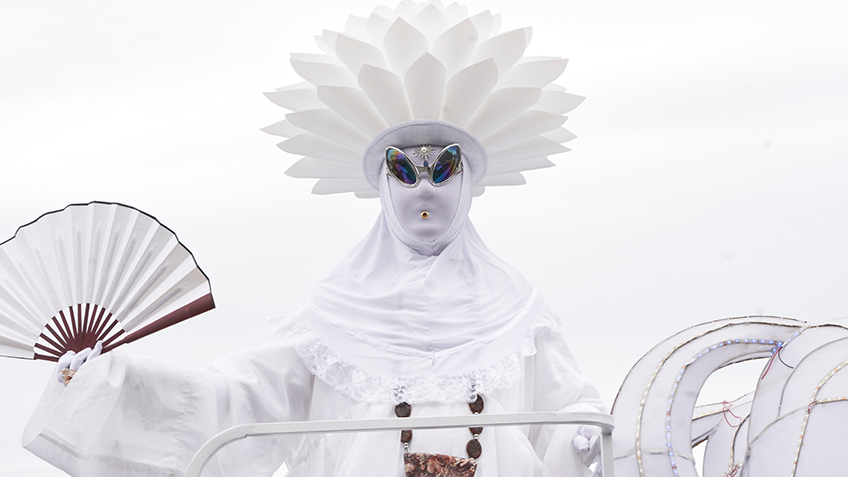September 2020 marks the 40th anniversary of Luke Roberts’ enduring performance art persona Pope Alice. Carriageworks’ Director of Programs, Daniel Mudie Cunningham, a long-time devotee, curated Luke Roberts/Pope Alice into The National 2019: New Australian Art. To celebrate Her Divine Holiness’s significant anniversary, we are honouring the occasion with an edited extract from Daniel’s 2012 monograph on Luke Roberts.
Her Divine Holiness Pope Alice’s first appearance in the contemporary art world was captured on film, blessing the exhibition Pope Alice Presents Luke Roberts at Spring Hill Gallery, Brisbane. While Pope Alice made various appearances throughout the 1980s, it was not until the 1990s that she became a ubiquitous presence at openings, festivals, parades, and parties. According to Timothy Morrell, Pope Alice ‘does not fit easily into existing conventions of performance art, and her manifestations are not so much performances as appearances (in the way that the Virgin Mary appears)’.1 For Pope Alice, appearances are everything—no one goes unblessed. Wherever she went, Pope Alice turned up in stretch-limousines to greet the hoi polloi, who hungrily snapped at her heels seeking photo opportunities with the divine. Papal holiness met Hollywood star. Despite the emphasis on humour and the carnivalesque, ‘Pope Alice was both self-vindication and an armoured vehicle of social protest’.2
Pope Alice’s debut emerged one year after Sydney’s first Mardi Gras in 1978 as Guest of Honour at the Swish Ball, a party event held in suburban Brisbane. This queer-rights protest march had erupted in police violence and fifty-three arrests as a queer underground rose to combat the criminalisation, victimisation, and pathologisation of homosexuality. Pope Alice would become a regular feature of the annual Mardi Gras parade—just some of many times she has blessed the crowds and kissed the bitumen.3 Michele Helmrich describes Pope Alice’s appearance at Sydney’s 1994 Mardi Gras parade:
Her Divine Holiness offered blessings and advice that ‘Heterosexuality is Curable’. Here, her ecclesiastical robes are embraced, her papal crown not so remote from the beehives sported by the Marge Simpson lookalikes. Pope Alice’s mere presence at the Mardi Gras sanctions the sexual license of the carnivalesque, whose traditions have been repressed by Puritanism.4
For Roberts, the ‘mystory’ of Her Divine Holiness Pope Alice is the greatest herstory of prehistory. According to legend, this white-clad papal emissary from the doomed Planet Metullana fell to Earth through a black hole in the year 5252ABCD. Where she landed is now known as Alice Springs (or, more correctly, ‘Pope Alice Springs into Wonderland’). She would go on to become the spiritual leader of the technologically advanced people of the continent Mu, which subsequently sank into the Pacific Ocean.
Accounts of her origins claim that Pope Alice ‘exists because millions of people made her up’.5 (With his many performance personae, perhaps Luke Roberts is this army of one.) However, over time it has become clearer that Luke Roberts exists because Pope Alice made him up. Hence the legend: Pope Alice Presents Luke Roberts to a World Made Flesh.6 Roberts says, ‘These days I see myself as more of a Pope Alice impersonator than as Pope Alice herself.’7 Ever since Pope Alice loved him to life, Roberts has been carving out a circuitous career path as a Pope Alice impersonator, a showman for shamans, a muse for drowned museums.
Like Alice Jitterbug, Pope Alice was conceived in reaction to Catholic repression, hypocrisy, and patriarchy. She ‘speaks for all those who are not embraced by Rome’.8 In 1998, curator Christine Morrow included Pope Alice in Ex.cat, her show about Catholicism in art. She argued that ‘Pope Alice engages serious theological ideas and humour to reflect on what is left out of depictions of the divine—especially the feminine.’9 Pope Alice recalls the mythic medieval Pope Joan, whose masquerade was exposed when she unexpectedly gave birth while mounted on a horse during a parade. Yet, despite her name, little seems feminine about Pope Alice—her shapeless gowns seem androgynous, at least to our human expectations.
Through Pope Alice, Roberts critiques Catholicism by perversely using its own language of spectacle and ritual. That his practice of questioning faith and religiosity endures suggests that such ‘personal demons’ can never be fully exorcised. In fact, one might argue that it is Roberts’s robust identification with the Church that makes Pope Alice plausible. You can take Luke Roberts out of the church, but you can’t take the church out of Luke Roberts.
With the help of Pope Alice, Roberts became a key figure in the 1990s among a new generation of Australian artists who exemplified the new ‘queer’ zeitgeist. Queer was a post-gay identity category, a response to both the homophobic mainstream and to over-prescribed gay identities. As a category that refused categorisation, an identity that denied identity, queer promised to reinvent transgression, subversion, playfulness, and pleasure. It ushered in a wave of cultural production, but was quickly absorbed into the mainstream and lost momentum. What made Roberts unique among the queer crowd was his rigorous critique of sexuality, religion, and history.
Queer was inclusive. The term was available to any individual or community who wished to lay claim to an ethos of difference. At once everything and nothing, it was a convenient idea (a pillow for the marginalised) but also a strategic one (emphasising fluidity and change). As Pope Alice gave refuge to all fringe-dwellers, her larger-than-life pontiff persona rendered everything she blessed as queer, even when her public appearances were not affiliated with ‘official’ queer events.
In 1995, Pope Alice was included in the Australian Perspecta at Sydney’s Art Gallery of New South Wales. This Australian-art survey show emphasised then-current cultural debates around identity and hybridity. Curator Judy Annear included artists who made ‘constructive use of difference and marginality in tandem with an inquiry into the history and techniques of art practice’.10 By situating ‘queerness’ within a broader set of debates about difference, the 1995 Perspecta stands out as one of the most engaging of the many queer shows produced at this time. Included as an official Mardi Gras festival event, it highlighted Roberts’s inclusion alongside other participating artists known for an established or emerging queer-art practice (David McDiarmid, Linda Dement, Mathew Jones, Neil Emmerson, and Brook Andrew).
Although it was not exhibited in Perspecta, a photo from Roberts’s provocative 1994 series Pope Alice and Archangel pointedly appeared in the catalogue. These five photographs show Pope Alice cavorting with a priapic Archangel, played by the then-current Mr Gay Queensland. In one image, her papal-gloved hand fondles his scrotum; in another she reams his celestial arse; in two images, she blows him. A queer pantomime for deific porn stars, this series mocks Judeo-Christian discourses of compulsory reproductive heterosexuality. This idea is most explicit in a photograph predating the Archangel series by a year: Pope Alice’s Miracle Baby/Pope Alice as Madonna with Child (1993). Here, as the Virgin, Pope Alice proudly present her immaculate offspring.
At the time these photographs were created, Pope Alice’s fame was reaching apocalyptic fever pitch. Busy romping with the Archangel one minute, having a Virgin birth the next, Roberts used Pope Alice as a conduit to disturb religious hang-ups over sex and sexuality. Through this persona, he could target and rail against the religious status quo, while maintaining a degree of faith in its fanciful lack of logic.
Extracted from Luke Roberts: AlphaStation/Alphaville by Daniel Mudie Cunningham. Institute of Modern Art, Brisbane, 2012.



